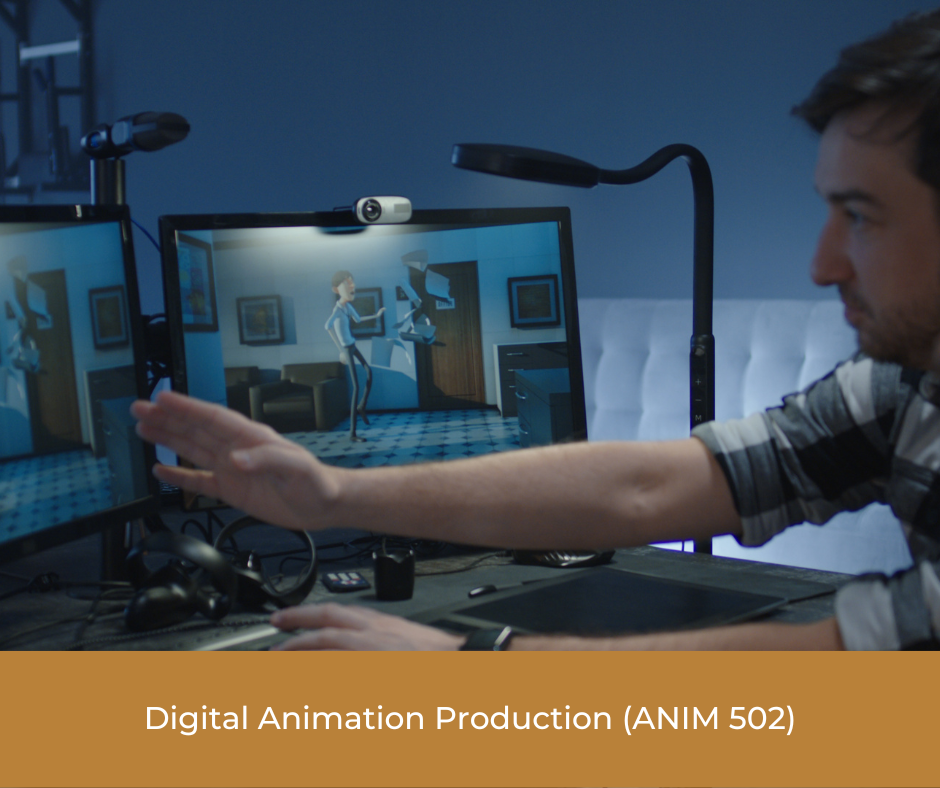Your cart is currently empty!
Digital Animation Production (ANIM 502)

Course Description
Digital Animation Production (ANIM 502) is a comprehensive course that guides students through the entire process of producing a digital animation project. From concept development to the final presentation, students will gain practical experience in every aspect of digital animation production. This course emphasizes teamwork, project management, and the application of animation techniques in a real-world context.
Outline of Major Content Areas
- Concept Development: Brainstorming, ideation, and storyboarding to create a compelling concept for the animation project.
- Scriptwriting: Writing and refining scripts that drive the narrative of the animation.
- Character Design: Creating and designing characters that are visually appealing and integral to the storyline.
- Storyboarding: Translating the script into visual sequences through detailed storyboards.
- 3D Animation Techniques: In-depth exploration of advanced 3D animation techniques, including modeling, rigging, and character animation.
- Project Planning and Management: Developing project timelines, assigning roles, and managing resources effectively.
- Production Pipeline: Understanding and implementing a structured production pipeline for animation projects.
- Digital Tools and Software: Mastery of digital animation tools and software used in the industry.
- Teamwork and Collaboration: Working collaboratively as a team, including communication, problem-solving, and conflict resolution.
- Rendering and Post-Production: Applying rendering techniques and post-production processes to enhance the final animation.
- Project Presentation: Preparing and delivering a professional presentation of the completed animation project.
Course Learning Outcomes
Upon completing Digital Animation Production (ANIM 502), students will:
- Concept Development: Demonstrate the ability to generate creative and engaging concepts for animation projects.
- Scriptwriting: Write and refine scripts that effectively drive the narrative of the animation.
- Character Design: Create visually compelling and relevant characters for animation.
- Storyboarding: Develop detailed and coherent storyboards that guide the animation production.
- 3D Animation Proficiency: Apply advanced 3D animation techniques, including modeling, rigging, and character animation.
- Project Planning and Management: Plan and manage animation projects efficiently, meeting deadlines and objectives.
- Production Pipeline Knowledge: Understand and implement a structured production pipeline for animation projects.
- Digital Tools Mastery: Demonstrate proficiency in using industry-standard digital animation tools and software.
- Teamwork and Collaboration: Collaborate effectively within a team, demonstrating communication and problem-solving skills.
- Rendering and Post-Production: Apply rendering techniques and post-production processes to enhance the quality of the animation.
- Project Presentation: Prepare and deliver a professional presentation of the completed animation project.
Methods for Assessing Student Learning
Assessment in Digital Animation Production (ANIM 502) focuses on evaluating students’ proficiency in digital animation production and their ability to work effectively in a team. Assessment methods include:
- Concept Development and Script Evaluation: Assessment of students’ ability to develop creative concepts and write compelling scripts.
- Character Design and Storyboarding Review: Evaluation of character design and storyboards for visual appeal and narrative coherence.
- Animation Project Progress Reports: Periodic assessments of project planning, management, and adherence to timelines.
- 3D Animation Projects: Review of students’ 3D animation projects, assessing modeling, rigging, and character animation skills.
- Production Pipeline Evaluation: Assessment of the implementation of a structured production pipeline.
- Digital Tools Proficiency Tests: Testing students’ proficiency in using digital animation tools and software.
- Teamwork and Collaboration Assessment: Evaluation of teamwork, communication, and problem-solving within the team.
- Rendering and Post-Production Quality: Assessment of the quality of rendering and post-production work in the animation.
- Project Presentation and Documentation: Evaluation of students’ ability to present their completed animation project professionally.
Digital Animation Production (ANIM 502) equips students with practical skills and knowledge in digital animation production. By working on a complete animation project, students gain valuable experience in project management, teamwork, and the application of advanced animation techniques.